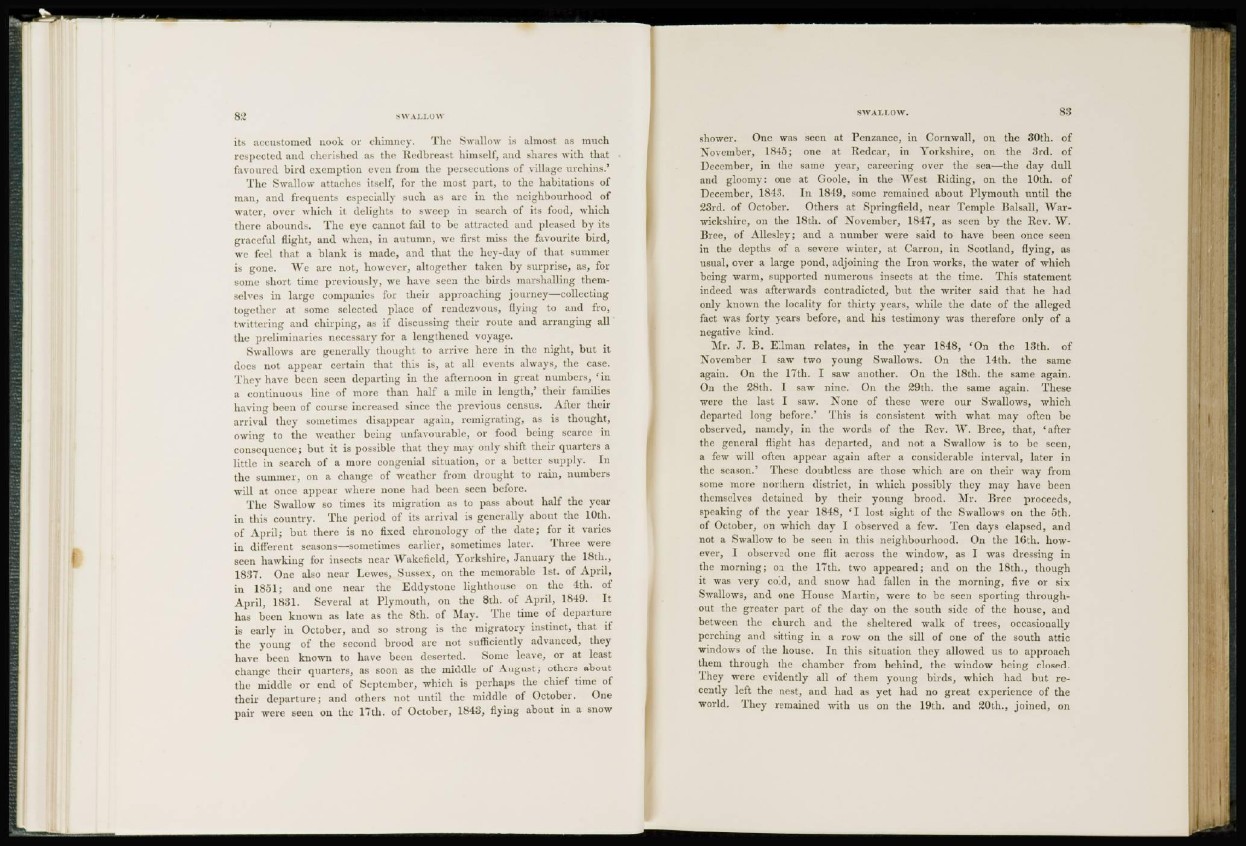
its accustomed nook or chimney. The Swallow is almost as much
respected and cherished as the Redbreast himself, and shares with that
favoured bird exemption even from the persecutions of village urchins.'
The Swallow attaches itself, for the most part, to the habitations of
man, and frequents especially such as arc in the neighbourhood of
water, over which it delights to sweep in search of its food, which
there abounds. The eye cannot fail to be attracted and pleased by its
graceful flight, and when, in autumn, we first miss the favourite bird,
we feel that a blank is made, and that the hey-day of that summer
is gone. We are not, however, altogether taken by surprise, as, for
some short time previously, we have seen the birds marshalling themselves
in large companies for their approaching journey—collecting
together at some selected place of rendezvous, flying to and fro,
twittering and chirping, as if discussing their route and arranging all
the preliminaries necessary for a lengthened voyage.
Swallows are generally thought to arrive here in the night, but it
does not appear certain that this is, at all events always, the case.
They have been seen departing in the afternoon in great numbers, 'in
a continuous line of more than half a mile in length,' their families
having been of course increased since the previous census. After their
arrival they sometimes disappear again, immigrating, as is thought,
owing to the weather being unfavourable, or food being scarce in
consequence; but it is possible that they may only shift their quarters a
little in search of a more congenial situation, or a better supply. In
the summer, on a change of weather from drought to rain, numbers
will at once appear where none had been seen before.
The Swallow so times its migration as to pass about half the year
in this country. The period of its arrival is generally about the 10th.
of April; but there is no fixed chronology of the date; for it varies
• in different seasons—sometimes earlier, sometimes later. Three were
seen hawking for insects near Wakefield, Yorkshire, January the 18th.,
1837. One also near Lewes, Sussex, on the memorable 1st. of April,
in 1851; and one near the Eddystone lighthouse on the 4th. of
April, 1831. Several at Plymouth, on the 8th. of April, 1849. It
has been known as late as the 8th. of May. The time of departure
is early in October, and so strong is the migratory instinct, that if
the young of the second brood are not sufficiently advanced, they
have been known to have been deserted. Some leave, or at least
change their quarters, as soon as the middle of August; others about
the middle or end of September, which is perhaps the chief time of
their departure; and others not until the middle of October. One
pair were seen on the 17th. of October, 1843, flying about in a snow
shower. One was seen at Penzance, in Cornwall, on the 30th. of
November, 1845; one at Redcar, in Yorkshire, on the 3rd. of
December, in the same year, careering over the sea—the day dull
and gloomy: one at Goole, in the West Riding, on the 10th. of
December, 1843. In 1849, some remained about Plymouth until the
23rd. of October. Others at Springfield, near Temple Balsall, Warwickshire,
on the 18th. of November, 1847, as seen by the Rev. W.
Bree, of Allesley; and a number were said to have been once seen
in the depths of a severe winter, at Carron, in Scotland, flying, as
usual, over a large pond, adjoining the Iron works, the water of which
being warm, supported numerous insects at the time. This statement
indeed was afterwards contradicted, but the writer said that he had
only known the locality for thirty years, while the date of the alleged
fact was forty years before, and his testimony was therefore only of a
negative kind.
Mr. J. B. Ellman relates, in the year 1848, 'On the 13th. of
November I saw two young Swallows. On the 14th. the same
again. On the 17th. I saw another. On the 18th. the same again.
On the 28th. I saw nine. On the 29th. the same again. These
were the last I saw. None of these were our Swallows, which
departed long before.' This is consistent with what may often be
observed, namely, in the words of the Rev. W. Bree, that, 'after
the general flight has departed, and not a Swallow is to be seen,
a few will often appear again after a considerable interval, later in
the season.' These doubtless are those which are on their way from
some more northern district, in which possibly they may have been
themselves detained by their young brood. Mr. Bree proceeds,
speaking of the year 1848, ' I lost sight of the Swallows on the 5th.
of October, on which day I observed a few. Ten days elapsed, and
not a Swallow to be seen in this neighbourhood. On the 16th. however,
I observed one flit across the window, as I was dressing in
the morning; on the 17th. two appeared; and on the 18th., though
it was very cold, and snow had fallen in the morning, five or six
Swallows, and one House Martin, were to be seen sporting throughout
the greater part of the day on the south side of the house, and
between the church and the sheltered walk of trees, occasionally
perching and sitting in a row on the sill of one of the south attic
windows of the house. In this situation they allowed us to approach
them through the chamber from behind, the window being closed.
They were evidently all of them young birds, which had but recently
left the nest, and had as yet had no great experience of the
world. They remained with us on the 19th. and 20th., joined, on